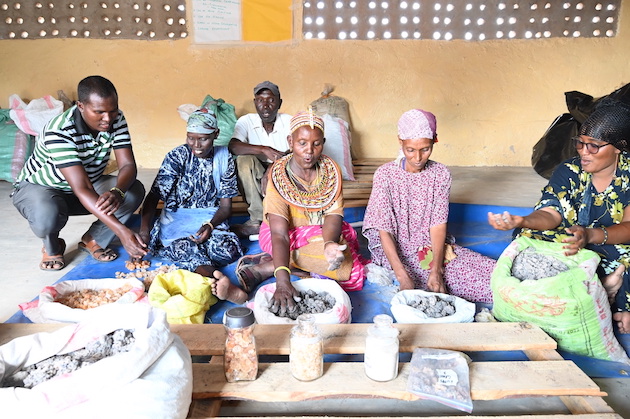[ad_1]

Nairobi, Jun 16 (IPS) – Clad in conventional regalia and necklaces of richly colored beads that kind magnificent patterns round their necks, a military of girls from the pastoral Rendile neighborhood that resides on the coronary heart of Marsabit, a county in Kenya’s arid north, is on a mission.
Shoulder-to-shoulder, they’re strolling in direction of financial freedom armed with related instruments up the hill to faucet gum and gum-resins from acacia bushes.
“We face a myriad of challenges. First, we’ve to fetch water earlier than harvesting gum from acacia bushes. We then kind and dry it earlier than taking it to the marketplace for sale. From gums and gum-resin gross sales, I’m able to meet my household’s wants. No must promote my sheep and goats at a throw-away worth,” says Caroline Sepina, a 47-year-old mom of six, as she rigorously types the gum, which retails at $ 5 (Ksh 550) per kilogram.
Gums and resins are hardened plant exudates obtained from Acacia, Boswellia and Commiphora species in African drylands.
In Kenya’s drylands, human survival is frequently confronted with a number of challenges with minimal choices for various livelihoods.
There are not any males inside the manyattas in Ndikir, a village situated within the Marsabit sub-county. Due to the drought, males have needed to transfer to the close by Samburu county, trying to find pasture and water for his or her livestock.
Right here, the ladies are left behind, however in contrast to previously, once they could be unemployed, they now have various livelihoods which counterpoint their livestock.
In response to Leuwan Kokton, assistant chief of the Ndikir sub-location, males normally migrate with the livestock to the close by Samburu county to keep away from extreme drought, with just a few livestock left to assist cater for kids’s maintenance and typically, treatment.
“By way of this financial enterprise, I wouldn’t have to promote sheep from my herds to cater for my family wants. All I must do is simply stroll to the close by bushes and faucet the non-wood merchandise, then promote them on the market. This helps me protect my sheep and goats,” Joseph Longelesh, a resident of Ndikir village informed IPS in an interview.
The gums and gum-resins of economic significance collected from the forests in Kenya embody arabic, myrrh, hagar and frankincense. Kenya has sources of gums and resins with industrial manufacturing confined to the nation’s drylands. Gum arabic comes from Acacia senegal or Acacia seyal, whereas industrial gum resins are myrrh from Commiphoramyrrha, Hagar from Commiphora holtziana and Frankincense from Boswellia neglecta S.
Historically, the resin of Myrrh Hagar is appropriate for treating irritation, arthritis, weight problems, microbial an infection, wounds, ache, fractures, tumours, gastrointestinal illnesses, snake bites and scorpion stings.
Tommaso Menini, the managing director for African Company for Arid Useful resource (AGAR), informed IPS that gum and resin are straight linked to environmental conservation. The thought is to make the pastoral communities see an alternate supply of livelihood aside from livestock.
“Hagar is now an extremely sought-after product from largely Chinese language patrons as a result of it’s extremely used of their conventional drugs. Having a virtually 1.4 billion Chinese language inhabitants implies that the demand is excessive,” Menini informed IPS.
“Within the final years, we’ve seen an growing presence of Chinese language patrons organising a base in Kenya. Earlier than, we had brokers who would ship a number of containers to China, however since they’re organising in Kenya, they’re now driving costs up as a result of there’s extra demand.”
For Janet Ahatho, assistant pure sources Director at Marsabit County, these non-wood merchandise have been in existence. Nonetheless, the locals had not been uncovered to its financial potential and the way to exploit them for financial positive factors.
“As a county authorities, we’ve mapped the areas and labored with the locals. The individuals who gather the merchandise and promote them are the herders themselves. They’ve hooked up that sort of significance to those bushes, therefore serving to in environmental conservation,” says Ahatho.
In Marsabit county, these non-wood merchandise are generally present in Laisamis, Moyale and North Horr sub-counties.
“Surroundings destruction is lowered as a result of we’ve environmental administration committees in every sub-county, and they’re those partaking the collectors and the sellers of the product. They’re educated to coach the neighborhood on why you will need to preserve the tree species,” says Ahatho.
In 2005, the Regional Centre for Mapping of Assets for Growth, by means of the technical cooperation programme of the UN Meals and Agricultural Organisation (FAO), carried out useful resource evaluation and mapping of gums and resins in Kenya.
For Ilkul Salgi, the World Imaginative and prescient’s Built-in Administration of Pure Assets for Resilience in Arid and Semi-Arid Lands (IMARA) discipline officer, the locals who reside in arid counties, together with Marsabit, are normally confronted with drought, conflicts and the way to preserve the atmosphere amid the local weather disaster.
Engineer Chidume Okoro, a Community for Pure Gums and Resin in Africa (NGARA) chairperson, says manufacturing is much from sustainable, notably for frankincense, with debarking continuously damaging or killing bushes.
In response to Chidume, manufacturing of gum and resin in massive portions for industrial functions needs to be finished with nice care, by coaching the locals on the way to do it sustainably whereas saving the acacia bushes.
“With a lot deal with exporting bulk uncooked supplies and poor administration of the useful resource, export markets are underexploited. Gender inequities and energy imbalances exist and in some instances have led to unequal entry and management over advantages from these pure sources,” Okoro informed IPS.
Since exploring the non-wood merchandise, Sepina says her kids have all the time had balanced meals, and she will pay her kids’s faculty charges.
IPS UN Bureau Report
Observe @IPSNewsUNBureau
Observe IPS Information UN Bureau on Instagram
© Inter Press Service (2022) — All Rights ReservedAuthentic supply: Inter Press Service
[ad_2]
Source_link


